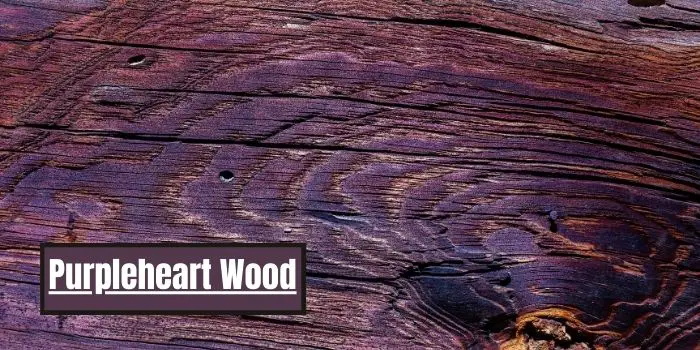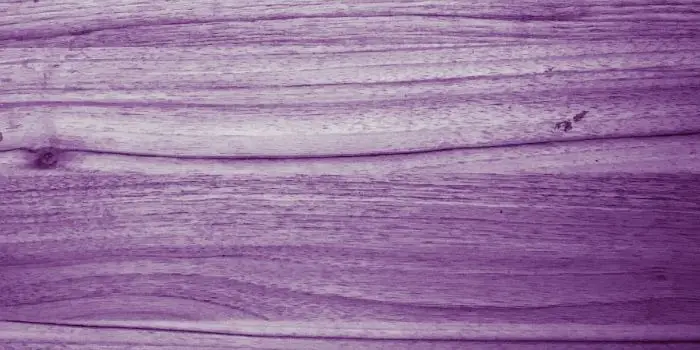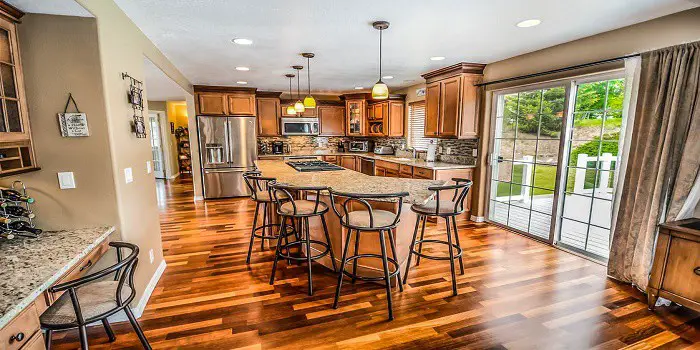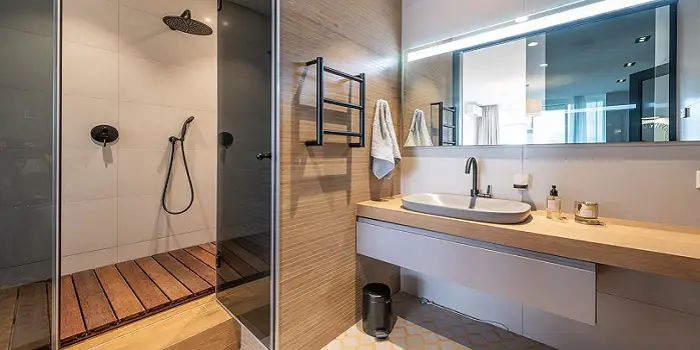
Purpleheart wood is a type of wood that many people love for its visual appeal, durability, and strength.
Its versatility and appearance make it a common choice for flooring, furniture, and beyond.
Below, we examine a few key points on purpleheart wood.
Purpleheart Wood
| Scientific Name: | Peltogyne spp. |
| Janka Hardness: | 2,520 lbf (11,190 N) |
| Type: | Hardwood |
| Average Dried Weight: | 56 lbs/ft3 (905 kg/m3) |
| Specific Gravity (Basic, 12% MC): | 0.76, 0.9 |
| Workability & Odor: | Not very easy to work with; most species do not have a characteristic odor |
| Durability: | Since it resists rot, decay, and most insect attacks, it’s durable |
Purpleheart Trees
Purpleheart wood comes from the purpleheart tree, which is a part of the Peltogyne genus consisting of 23 different species of big trees that are a part of the Fabaceae family.
These trees are known for their small floral blooms consisting of five petals and pod-shaped fruit that contain a single seed.
Purpleheart trees can grow as high as 30 to 50 meters (about 100 – 170 feet) and have a trunk diameter of an impressive 1.5 meters (3-5 ft).
Purpleheart trees are native to warm, tropical climates, with most of the species found in the Amazon Basin.
They thrive in tropical locations, so they can also be found in the Amazon rainforest and certain areas of Central America. The most common locations for these trees include:
- Bolivia
- Brazil
- Colombia
- Costa Rica
- French Guiana
- Guyana
- Mexico
- Panama
- Trinidad
- Venezuela
Purpleheart trees are given different names depending on where they are located. A few other names you may hear instead of Purpleheart are:
- Amarante
- Amaranth
- Dabam
- Guarabu
- Koroboreli
- Morado
- Palo Morado
- Pau Roxo
- Purperhart
- Sacka
- Sackaballi
- Tananeo
- Violetwood
The wood is so strong that it can be used in high-impact environments like construction and scaffolding.
However, because the unique qualities of this kind of wood have resulted in higher levels of exploitation of lumber, many countries have put laws into place about processing and even cutting this type of tree.
Wood Color & Grain
Purpleheart is known for its beautiful grain pattern as well as its color, one that is difficult to find in other kinds of wood.
It usually features a straight grain, although sometimes it may show other patterns or be wavy.
The inside of the Purpleheart provides grayish purple hardwood that gradually changes its hue to a rich violet and eventually to a deep purple color.
This change is tied to the presence of UV rays that can alter the appearance of the top layer.
In an attempt to reduce the chance of the wood changing color, it can be coated with an anti-UV ray sealant, or it can also be sanded down.
The wood has a high degree of natural luster and features a straight grain that is visually appealing.
Even so, the grain can be difficult to cut through and drill properly.

What is the Wood Used for?
Purpleheart wood is a hardwood. The super-strength of Purpleheart wood combines with its appearance to make it one of the most sought-after kinds of wood on the commercial lumber market.
Its versatility is a key selling point, and the wood is in high demand in a variety of industries.
Purpleheart wood is commonly seen used for durable furniture, paneling, flooring & tabletops, and structural elements, such as arches, boats, columns, industrial flooring, and various types of heavy construction.
Other common uses for Purpleheart wood include:
- Boatbuilding
- Bridge-building
- Cladding
- Columns (load-bearing)
- Decorative veneers
- Dock works
- Flooring
- Furniture
- General Carpentry
- Heavy outdoor construction projects
- Indoor and outdoor decoration
- Inlay
- Luxury coffins
- Marquetry
- Musical Instruments
- Paneling
- Specialty wood products
- Stairways
- Turning
- Tool handles
- Vats
Spiritual Uses
It can be hard to trust for many, but many believe that Purpleheart is a spiritual wood and can be used for enhancing creative energy and knowledge.
The wood is also known for its healing power, because of which it’s helpful in eliminating negative energies and tension in the home.
There are cultures where many people believe in wearing rings, watches, etc., made of purpleheart wood due to these qualities.
But wait, before you plan to use the wood for healing purposes in your home, it’s good to know about its toxicity.
Is Purple Heart Wood Toxic?
No, purpleheart wood isn’t toxic, but it’s considered to be a sensitizer.
Sensitizers are substances that can cause sensitization in the lungs, eyes, or skin.
Although serious reactions are extremely rare, there are cases where people and pets have experienced irritation in the eyes and skin when exposed to this wood.
It’s much like poison ivy that can cause nausea, along with eye and skin discomfort, to some people, especially those who are sensitive to allergies.
If you are putting purpleheart wood to use in your home, it’s good to test if you or your family members are sensitive to it or not.
Just take some wood dust and try to smell it or touch it. If you are sensitive to it, you will most likely get some form of irritation.
Why is Purpleheart Wood Expensive?
Purpleheart is a highly prized type of wood that is popular around the world not just because of its one-of-a-kind appearance but also due to its durability.
Unfortunately, it can only be found in rainforests, and cutting trees down in rainforests tends to lend itself to greater expenses.
This is partly because of the transportation costs and partly because of the restrictions that are placed on logging and exporting for sustainability reasons.
Purpleheart wood is also difficult to work with because it is a thick and hearty wood that is highly capable of withstanding pests and the weather.
The extractives that bring about the properties of this wood are gummy and thick and can often make a mess of woodworking tools.
Purpleheart wood can bring headaches in other ways as well, in that it has a high chance of causing tear-outs during the plane-cutting process due to the dense grain.
The high density may also heat the cutting tools, which could result in the internal melting of the resin.
These properties of wood altogether make the pricing on the higher side of the spectrum which can sometimes go as high as $40 to $50 per board foot.
Final Thoughts
Purpleheart is a truly special type of wood from the Amazon Basin.
It is not an eco-friendly wood choice, but it is used in everything from musical instruments to industrial flooring.
Though many people want it, it can be quite expensive and difficult to work with.
For indoors, it can be a great choice, but if you are considering an option that can be left outside, you might consider something other than purple wood.

Hi, I am Mark Garner a professional carpenter, woodworker, and DIY painter. I live in the small city of Peoria, Arizona as a semi-retired woodworker. I have started this blog with a simple motive to help you with my wood experience in this sector. If you like to know more about what I love doing and how it all got started, you can check more about me here.





